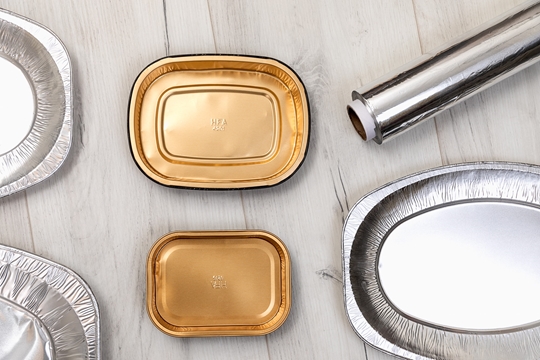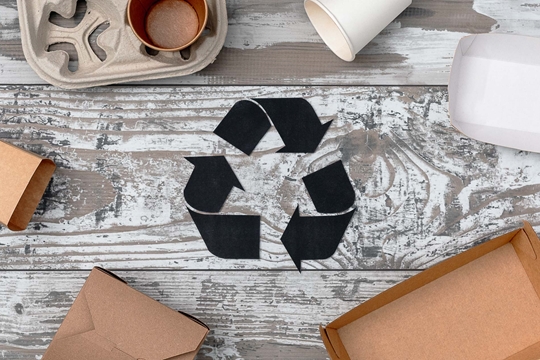Material guide: Plastic.
Our product range includes products made of PET, PS, PP, PVC, etc. Everyone has the different characteristics and in our plastic guide you can learn the different materials and learn what material is right for your products.
Our product range includes products made of PET, PS, PP, PVC, etc. Everyone has the different characteristics and in our plastic guide you can learn the different materials and learn what material is right for your products.
There are several types of plastic materials that can be used to make food packaging products and carrier bags. Regarding use of plastic, there are some basic rules that you can use and the most important thing is never to use a packaging for anything other than they are intended for.
It is important that substances from plastic dont migrate and destroys the food. The extent to which this could happen depends on the characteristics of the food. For example: Foodw with high fat, acidity, temperature or long storage time may increase the migration of certain substances from the plastic. Therefore, consider choosing the a plastic material that suits the food you have in your business.
|
Material |
Apperance |
Temperature |
Application |
Timeperiod* |
Microwaveable |
|
APET |
Clear |
-40°C – +70°C |
All types of food |
Long time |
No |
|
RPET |
Clear |
-40°C – +70°C |
All types of food |
Long time |
No |
|
CPET |
Turbid |
-40°C – +220°C |
All types of food |
Long time |
Yes |
|
PS |
Clear |
-40°C – +70°C |
Dry and cold foods |
Short time |
No |
|
OPS |
Clear |
-40°C – +70°C |
Dry and cold foods |
Short time |
No |
|
EPS |
White, foamy |
0°C – +70°C |
Dry and cold foods |
Short time |
No |
|
HIPS |
Clear |
0°C – +70°C |
Dry and cold foods |
Short time |
No |
|
PP |
Semitransparent |
-18°C – +130°C |
All types of food |
Long time |
Yes |
|
BOPP |
Clear |
-18°C – +130°C |
All types of food |
Long time |
Yes |
|
PLA |
Clear |
0°C – +40°C |
Cold foods |
Short time |
No |
|
LDPE |
White / Natural |
-20°C – +90°C |
All types of food |
Short time |
Yes |
|
MDPE |
White / Natural |
-20°C – +120°C |
All types of food |
Short time |
Yes |
|
HDPE |
White / Natural |
-20°C – +120°C |
All types of food |
Short time |
Yes |
|
PVC |
Clear, bluish tone |
-10°C – +80°C |
Avoid contact with fatty foods |
Short time |
No |
|
PC |
Clear, bluish tone |
-40°C – +100°C |
All types of food |
Long time |
Yes |
* Migration tests of the products are issued by the manufacturer to determine exact test conditions and to ensure that relevant legislation is followed.
PET (Polyethylene Terephthalate) is a common material for packaing products such as bottles and food containers.
PET is useful because of its stability, low weight and transparent appearance, which makes it great for food display. Another advantage of PET is that it can be 100% recycled and reused to make new products.
Three common variants of PET plastic are APET (Amorf PET), RPET (Recycled PET) and CPET(Crystalline PET).
APET is a durable and lightweight material. It is a popular material for food conatiners. The material is glossy, durable and with high visability which makes it perfekt for food presentation.
| Name: | Amorphous Polyethylene Terephthalate |
| Appearance: | Clear |
| Raw materials: | Oil |
| Temperature: | -40°C till +70°C |
| Microwavable: | No |
| Recyclable: | Yes, as plastic packaging |
rPET products is made from recycled plastic, such as PET bottles. In the production, the plastic is sorted, cleaned and ground to flakes and then converted to reuse as a new product.
| Name: | Recycled polyethylene terephtalate |
| Appearance: | Clear |
| Raw material: | Crude oil (recycled PET) |
| Temperature: | -40°C to +70°C |
| Microwavable: | No |
| Recyclable: | Yes, plastic recycling |
CPET apperance is somewhat more turbid compare to APET and RPET plastic because the plastic is partially crystallized in its structure. This makes the material stronger and make it maintain shape at higher temperatures. Food packaging products made of CPET often has a APET outer layer to give the product a glossy appearance.
| Name: | Crystalline polyethylene terephthalate |
| Appearance: | Turbid |
| Raw materials: | Crude Oil |
| Temperature: | -40°C to +220°C |
| Microwavable: | Yes |
| Recyclable: | Yes, plastic packaging |
PE (Polyethylene) is a plastic material based on hydrocarbon and is suitable for combustion. PE has a high elasticity for temperatures and can withstand low temperatures. PE is also resistant to chemicals, insensitive to moisture and can be used in water. During production, no chemicals are added or disposed of with the exception of any dyes that may be added to color the product. Common products made from PE are plastic bags, bottles, caps and films.
PE is classified by its density and branching. Here are the three most common types of PE used in disposable products:
| Name: | Polyethylene |
| Appearance: | White / natural color |
| Raw Materials: | Natural gas / hydrocarbon |
| Temperature: |
-20 ° C to + 90 ° C for LDPE -20 ° C to + 120 ° C for HDPE and MDPE |
| Microwavable: | Yes, MDPE and HDPE |
| Recyclable: | Yes, plastic recycling |
PS (Polystyrene) is a common and cheap thermoplastic made of ethylbenzene. PS plastic is a strong and clear plastic.
PS occurs in both crystallized and uncrystallized form, where the crystallized PS more translucent and uncrystallized PS is somewhat stronger.
Two common variants of PS used in disposable products are OPS (Oriented Polystyrene) and HIPS (High Impact Polystyrene).
OPS is produced by stretching extruded PS film in two directions, lengthwise and transversely. This process increases stiffnes in the material and improving the visibility. The main use of OPS is transparent food containers and lids due to its clear apperance. OPS is primarily suitable for cold and dry foods and is not suitable for warm food.
| Name: | Oriented Polystyrene |
| Appearance: | Clear |
| Raw materials: | Crude Oil |
| Temperature: | -40°C to +70°C |
| Microwavable: | No |
| Recyclable: | Yes, plastic recycling |
HIPS is a polystyrene to which you addebutadiene rubber to make the material softer and gives it a higher toughness which makes the plastic moldable. The material is primarily suitable for cold and dry foods and food containers made from HIPS is not intended for heating. Due to the rubber substance, HIPS is more resistant to fat than OPS.
| Name: | High Impact Polystyrene |
| Appearance: | Clear |
| Raw materials: | Crude Oil |
| Temperature: | 0°C to + 70°C |
| Microwavable: | No |
| Recyclable: | Yes, plastic recycling |
PP (Polypropylene / Polypropylene) is a light-weight thermoplastic polymer with high resistance to chemical stress. PP has a good resistance to fatigue, which means it can bend and fold several times without breaking the material.
The material wide variety of applications and commonly used for food packaging products. PP is resistant to high temperatures and can often be used on microwaves. The material becomes brittle at low temperatures and the glass transition temperature is about -20°C.
| Name: | Polypropylene |
| Appearance: | Cloudy |
| Raw materials: | Crude Oil |
| Temperature: | -18°C to +130°C |
| Microwavable: | Yes |
| Recyclable: | Yes, plastic recycling |
BOPP (Biaxially Oriented Polypropylene) is often in packaging products, plastic bags and plastic films. "Biaxially oriented" means that the material is stretched in two different directions, which increases strength and clarity of the material. BOPP can be used for both hot and cold foods.
| Name: | Biaxially oriented polypropylene |
| Appearance: | Clear |
| Raw materials: | Crude Oil |
| Temperature: | -18°C to +130°C |
| Microwavable: | Yes |
| Recyclable: | Yes, plastic recycling |
PVC (polyvinyl chloride) is a clear, hard and dense plastic that is not broken down by chemicals. PVC contains chlorine, is flame retardant and can be manufactured in several grades. The material itself is relatively rigid, therefore, in some cases you add softeners to facilitate handling and shaping of the material. Mostly, plasticizers are used for products like food film or disposable gloves, where you want a more elastic material.
PVC is often used for plastic food packaging film like for meat. It is also a common material in bottles and containers for detergents.
PVC plastic products containing certain phthalates (Benzyl Butyl Phthalate (BBP), Diisonyl Phthalate (DINP) and Diisodecyl Phthalate (DIDP)) should not be used in the handling of fatty foods.
| Name: | Polyvinyl Chloride |
| Appearance: | Clear with bluish tone |
| Raw materials: | Chlorine and coal |
| Temperature: | -10°C to +80°C |
| Microwavable: | No |
| Recyclable: | Yes, plastic recycling |
PC (Polycarbonate) is a very durable plastic and is often described as "unbreakable plastic". PC is useful because of the combination that it can withstand both heat and cooling very well. Common area of use for PC is kitchen utensils that most withstand high temperatures and glassware for outdoor use. The material is also used for plastic and plastic packaging that are intended to be discarded and reused.
| Name: | Polycarbonate |
| Appearance: | Clear with light gray tone |
| Raw materials: | Crude Oil |
| Temperature: | -40°C to +100°C |
| Microwavable: | Yes |
| Recyclable: | Yes, plastic recycling |
Author: Tingstad
Last Updated: 2023-12-18
Read more about our other materials, such as Aluminum. We will help you find out if the material can be used in the oven or microwave oven and if the material can be recycled, etc.
Read moreIn our range we have several different products made from renewable raw materials. Examples of renewable materials are PLA (from corn starch / sugar cane), paper (from trees), and bagasse (sugar cane fibers). Learn more about the different materials in our guide.
Read moreMany containers contain valuable materials which we through recycling can save both raw materials and energy. Here you can read more on how to recycle different materials.
Read more










